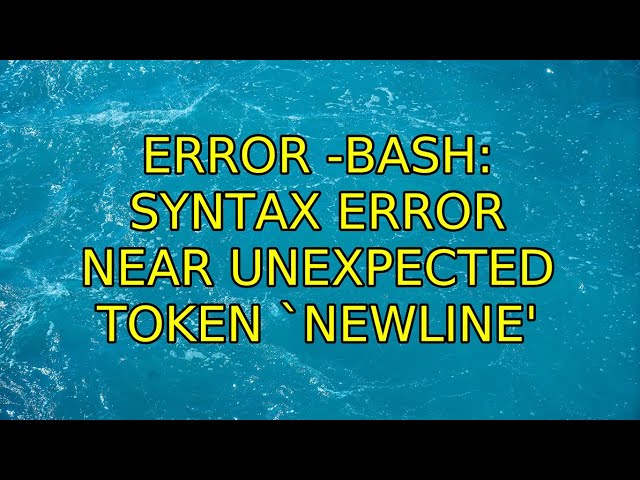
Introduction:
Fix Bash Syntax Error Near Unexpected Token, It’s become customary to code using the Linux Bash Terminal, near Unexpected Token. A multitude of faults are encountered by students studying programming languages and software engineering. It is possible to get into the unexpected token “newline” issue when working with Bash scripts. It might interfere with how your script runs. The first step in fixing this problem is to comprehend it. All of these error details are covered in this post. We’ll figure out what causes it and how to fix it so it doesn’t happen again. Okay, let’s go!
What Is the Bash: Syntax Error Near Unexpected Token “Newline”
When executing a Bash script, you may run into the unexpected token “newline” error due to different reasons. This error occurs when Bash detects unexpected characters in your script or input. If you are facing this error, a syntax error in your script is causing it. We will give different instances where the error can occur and see How to Fix Bash Syntax Error Near Unexpected Token.
Example 1: Unquoted Angle Brackets:
While writing a Bash script, quote any angle brackets you use in your code. Bash won’t read it as an angle bracket until then. If not, the unexpected token “newline” error is raised.
When we attempted to run a Bash script on the terminal in the following image, we received the following syntax error:

Opening your script in a text editor is the first thing you should do if you run into this kind of problem. In this instance, the nano editor is used.

Look for any code that has unquoted angle brackets when you open the script. That is the primary reason for the mistake. The reason for the syntax error is that our str variable contains an unquoted string, as we can see in the preceding image. This inaccuracy can be corrected by quoting it as follows:

We can successfully execute the script if we quote it as anticipated by Bash and then run the identical script again.

Example 2: Using the Angle Brackets in the Bash Command Line Parameters:
The unexpected token “newline” error is raised when you add angle brackets without quoting them in a Bash script that accepts user input for arguments in a parameter.

Make careful to cite any arguments you choose to present that are enclosed in angle brackets. We can find the source of the mistake by looking at the syntax if we open the Bash script.

We can see that we are accepting the arguments from the user input in the preceding script code. The syntax issue appears because we have to add the arguments as we did when we ran the script. We can see that we typed an angle bracket in the second argument in the user input, which prompts Bash to raise a syntax error.

However, if we quote the angle bracket and enter it again, we successfully run the Bash script without errors.

After quoting the angle brackets, we were able to print the output on the terminal in accordance with the script.
Therefore, the first thing to do if you receive the error “Bash: syntax error near unexpected token “newline'” is to examine the code in your script to find the error. Additionally, see if your code contains any parameters and whether the problem is the result of a mistake in the argument you entered on the terminal.
Fix 1: Use a Backslash to Escape Parenthesis
The workaround is to backslash before each parentheses bracket if you insist on having a file name in parenthesis. This is sometimes referred to as “escaping the parenthesis,” and it looks like this: \( and\). Before each parenthese is the backslash character.
In our previous example, we could easily generate our file in the following manner.
$ touch sample_file\(data\).txt
By escaping the parentheses, you can see that we successfully generated the file without any problems in the following output.
Backslash Is Used to Get Out of Parenthesis
As demonstrated below, the same idea holds true whether moving, deleting, and renaming the file.
$ cp sample_file\(data\).txt /tmp/ $ rm sample_file\(data\).txt
Fix 2: Enclose File Inside double Quotes:
Alternatively, you might put double quote marks around the entire file name. There will be no problems with this trick either.
$ cp "sample_file(data).txt" /tmp $ rm "sample_file(data).txt"
Using the above methods will help you come out of this error and seamlessly perform operations on your files.
Conclusion:
There you have it! We have shown how to resolve the Linux error “bash: syntax error near unexpected token ‘(‘)” in this quick tutorial. As you can see, the solution is really easy to implement. We appreciate your input.
For more details let connect with our website linuxhints.info
Get more information about
How to Check Availability by Using Ping in Bash Scripts
